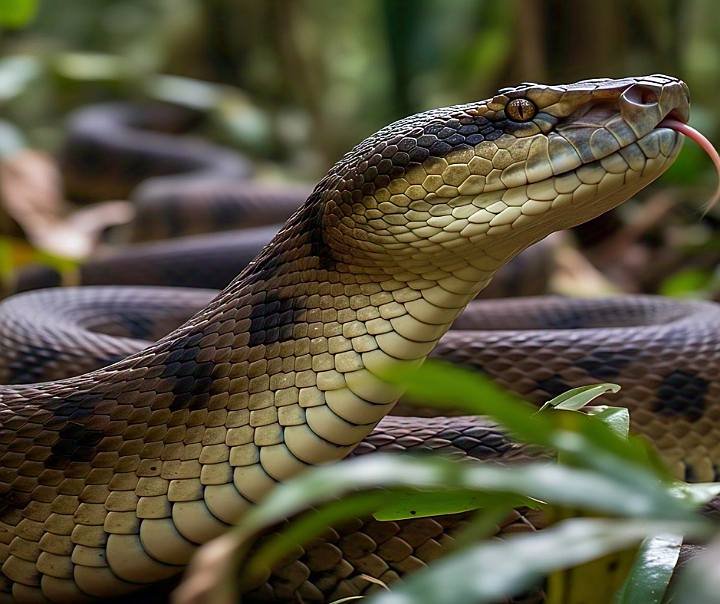The 10 Most Dangerous Snake in the World
Snakes are among nature’s most enigmatic creatures, captivating and terrifying humans with their beauty, agility, and, in some cases, deadly venom. With over 3,000 snake species worldwide, a select few possess venom so potent that a single bite can kill a human in minutes. In this detailed blog post, we explore the 10 most dangerous snake in the world, delving into their habitats, venom characteristics, behaviors, and impacts on humans, alongside fascinating facts.
10 Most Dangerous Snake List in the World
Here’s a list of the 10 most dangerous snake in the world, based on their venom potency, aggression, and impact on humans. Note that “dangerous” considers both the snake’s venom toxicity and its likelihood to encounter or bite humans.
1. Inland Taipan
Scientific Name: Oxyuranus microlepidotus
Habitat: Central and eastern Australia
Venom Lethality: The world’s most venomous snake
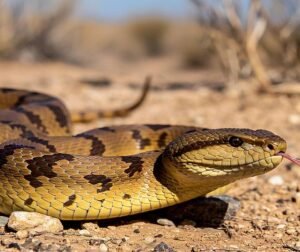
The inland taipan, also known as the small-scaled snake, holds the title of the world’s most venomous snake. Its venom is so potent that a single bite contains enough toxin to kill 100 adult humans or 250,000 mice. The venom is a lethal cocktail of hemotoxins and neurotoxins, destroying blood cells and paralyzing the nervous system.
Characteristics:
- Length: 1.8–2.5 meters
- Color: Varies with seasons; dark brown in summer, light olive in winter
- Diet: Small mammals, primarily rodents
Why It’s Dangerous:
The inland taipan’s venom acts so rapidly that, without timely antivenom, death can occur within minutes. Fortunately, its shy nature and remote habitat in Australia’s outback make human encounters rare. Its bite causes severe internal bleeding, muscle damage, and neurological impairment.
Fascinating Facts:
- The inland taipan’s venom is studied in neurological research due to its extreme potency.
- It can deliver multiple bites in a single attack, amplifying venom delivery.
See this for more information: Australian Museum – Inland Taipan
2. King Cobra
Scientific Name: Ophiophagus hannah
Habitat: South and Southeast Asia (India, China, Indonesia)
Venom Lethality: Up to 7 ml of venom per bite
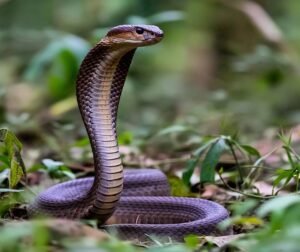
The king cobra is the world’s longest venomous snake, capable of reaching lengths of up to 5.5 meters. Known for its intelligence and aggressive behavior, its venom consists of potent neurotoxins that can paralyze the respiratory system.
Characteristics:
- Length: 3–5.5 meters
- Color: Olive green, black, or brown with yellow bands
- Diet: Other snakes, especially rat snakes
Why It’s Dangerous:
A single bite from a king cobra can deliver enough venom to kill an adult elephant. When threatened, it raises its hood, hisses loudly, and strikes with precision. In India’s forests, king cobra bites are a significant concern, often leading to fatalities if untreated.
Fascinating Facts:
- The king cobra is the only snake known to build a nest to protect its eggs.
- Its diet primarily consists of other snakes, earning it the title “king of snakes.”
See this for more information: National Geographic – King Cobra
3. Russell’s Viper
Scientific Name: Daboia russelii
Habitat: South Asia (India, Sri Lanka, Bangladesh)
Venom Lethality: Hemotoxic, causing bleeding and organ failure
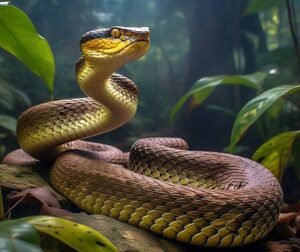
Russell’s viper is responsible for a significant number of snakebite deaths in India. Its hemotoxic venom disrupts blood clotting, leading to severe internal and external bleeding.
Characteristics:
- Length: 1–1.5 meters
- Color: Brown with yellow or brownish spots
- Diet: Rodents, frogs, small birds
Why It’s Dangerous:
Russell’s viper has an irritable temperament and is commonly found near human settlements, such as agricultural fields. Its bite can cause kidney failure, hemorrhaging, and tissue damage. In India, thousands of snakebite cases annually are attributed to this species.
Fascinating Facts:
- Named after British herpetologist Patrick Russell, who studied Indian snakes.
- Its bite causes excruciating pain, often described as unbearable by victims.
See this for more information: World Health Organization – Snakebite
4. Black Mamba
Scientific Name: Dendroaspis polylepis
Habitat: Sub-Saharan Africa
Venom Lethality: Fast-acting neurotoxin
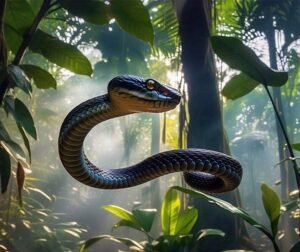
The black mamba is one of the fastest and deadliest snakes, named for the black interior of its mouth, which it displays when threatened. Its neurotoxic venom rapidly shuts down the respiratory system.
Characteristics:
- Length: 2–4.5 meters
- Color: Olive green, brown, or gray (black mouth)
- Diet: Small mammals, birds
Why It’s Dangerous:
Capable of speeds up to 20 km/h, the black mamba can strike multiple times in quick succession. A bite can lead to death within 20 minutes to 4 hours if untreated. In Africa, its bites are a leading cause of snakebite fatalities.
Fascinating Facts:
- The black mamba’s venom is so fast-acting that victims may collapse within minutes.
- It is highly aggressive and may attack without provocation when cornered.
See this for more information: African Snakebite Institute – Black Mamba
5. Death Adder
Scientific Name: Acanthophis antarcticus
Habitat: Australia, New Guinea
Venom Lethality: Neurotoxic, affecting respiratory function
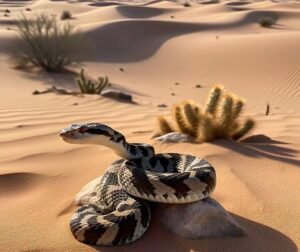
True to its name, the death adder is a master of ambush. Its neurotoxic venom paralyzes prey, making it one of Australia’s deadliest snakes. It lures prey by wiggling its tail like a worm.
Characteristics:
- Length: 0.4–1 meter
- Color: Brown, red, or gray with banded patterns
- Diet: Small mammals, birds, reptiles
Why It’s Dangerous:
The death adder’s venom acts swiftly, causing paralysis and respiratory failure. Its camouflage and proximity to human paths increase the likelihood of bites, which are considered medical emergencies in Australia.
Fascinating Facts:
- The death adder uses its tail as a lure, mimicking insect movement to attract prey.
- Its bite is among the most dangerous in Australia, requiring immediate antivenom.
See this for more information : Australia Zoo – Death Adder
6. Tiger Snake
Scientific Name: Notechis scutatus
Habitat: Southern Australia, Tasmania
Venom Lethality: Mix of neurotoxins and hemotoxins

The tiger snake is named for its vibrant, tiger-like stripes. Its venom, a combination of neurotoxins and hemotoxins, affects both the nervous system and blood cells.
Characteristics:
- Length: 1–2 meters
- Color: Black, yellow, or brown with distinct bands
- Diet: Frogs, rodents, birds
Why It’s Dangerous:
Tiger snakes are highly aggressive and strike readily when threatened. Their bites cause muscle weakness, paralysis, and severe bleeding. They are a leading cause of snakebite incidents in southern Australia.
Fascinating Facts:
- The tiger snake’s venom is among Australia’s most potent.
- It can survive in colder climates, making it a versatile and widespread threat.
See this for more information: St John Ambulance – Tiger Snake
7. Saw-Scaled Viper
Scientific Name: Echis carinatus
Habitat: Middle East, Africa, India
Venom Lethality: Hemotoxic, causing severe bleeding

The saw-scaled viper, though small, is one of the deadliest snakes due to its irritable nature and proximity to human habitats. Its name comes from the rasping sound produced by rubbing its scales together.
Characteristics:
- Length: 0.3–0.9 meters
- Color: Brown, gray, or red with spots
- Diet: Rodents, lizards, insects
Why It’s Dangerous:
The saw-scaled viper’s aggressive behavior and presence in populated areas make it responsible for more snakebite deaths globally than any other species. Its hemotoxic venom causes uncontrollable bleeding and organ damage.
Fascinating Facts:
- The viper produces a distinctive “sizzling” sound by rubbing its scales.
- Its bites can lead to permanent organ damage if not treated promptly.
See this for more information: WHO – Snakebite Management
8. Boomslang
Scientific Name: Dispholidus typus
Habitat: Sub-Saharan Africa
Venom Lethality: Hemotoxic, causing severe bleeding

The boomslang is a colorful, arboreal snake with a highly potent hemotoxic venom that disrupts blood clotting, leading to internal and external hemorrhaging.
Characteristics:
- Length: 1–1.8 meters
- Color: Green, brown, or multicolored
- Diet: Birds, frogs, small reptiles
Why It’s Dangerous:
Though its venom acts slowly, the effects are devastating, causing massive bleeding. Bites are rare due to its arboreal lifestyle, but when they occur, they are life-threatening.
Fascinating Facts:
- The boomslang has large eyes, granting it excellent vision for hunting.
- Its jaw can open up to 170 degrees, allowing it to swallow large prey.
See this for more information: South African Snake Institute
9. Fer-de-Lance
Scientific Name: Bothrops asper
Habitat: Central and South America
Venom Lethality: Hemotoxic, causing tissue damage

The fer-de-lance is a large, aggressive pit viper found in Central and South America. Its hemotoxic venom causes severe tissue damage and bleeding.
Characteristics:
- Length: 1.2–2.5 meters
- Color: Brown or gray with diamond-shaped patterns
- Diet: Rodents, birds, frogs
Why It’s Dangerous:
The fer-de-lance’s aggressive nature and presence near human settlements make it a significant threat. Its bite causes intense pain, swelling, and tissue necrosis, often requiring surgical intervention.
Fascinating Facts:
- Its name, meaning “spearhead” in French, refers to its lance-shaped head.
- It is a master of camouflage in rainforests, making it hard to spot.
See this for more information: Smithsonian – Fer-de-Lance
10. Rattlesnake
Scientific Name: Crotalus spp.
Habitat: North and South America
Venom Lethality: Mix of hemotoxins and neurotoxins
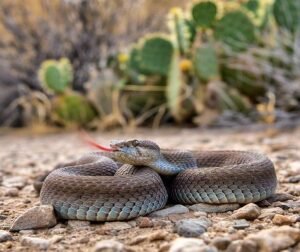
Rattlesnakes are iconic for the rattling sound produced by their tails. Their venom, a mix of hemotoxins and neurotoxins, causes tissue damage and paralysis.
Characteristics:
- Length: 0.5–2.5 meters
- Color: Brown or gray with diamond patterns
- Diet: Rodents, rabbits, birds
Why It’s Dangerous:
Rattlesnake bites cause severe pain, swelling, and tissue damage. In the Americas, they are a common cause of snakebite injuries, particularly in rural areas.
Fascinating Facts:
- The rattle is made of keratin, the same material as human fingernails.
- Rattlesnakes use heat-sensing pits to hunt in complete darkness.
See this for more information: National Park Service – Rattlesnakes
Prevention and Treatment of the Most Dangerous Snake Bites
To avoid snakebites, follow these precautions:
- Wear Protective Gear: Use sturdy boots and long pants in forests or grasslands.
- Stick to Paths: Avoid tall grass or bushes in unfamiliar areas.
- Don’t Provoke Snakes: Most snakes only attack when threatened.
- First Aid: Stay calm, keep the bitten limb below heart level, and seek immediate medical help.
Treatment:
- Antivenom: Administered based on the snake species identified.
- Medical Monitoring: Vital signs like blood pressure, respiration, and heart rate must be closely monitored.
See this for more information: CDC – Snakebite Treatment
Cultural Significance and Myths
Snakes have long been symbols in human culture. In Hinduism, the cobra is associated with Lord Shiva, representing divine protection. In African folklore, the black mamba is a harbinger of death. Aboriginal Australians weave snakes into creation stories, viewing them as embodiments of the land’s spirit. Conversely, myths often exaggerate snake dangers, portraying them as malevolent creatures when most bites result from human provocation.
Conservation and Coexistence of Most Dangerous Snake
Many of these snakes face habitat loss due to deforestation and urbanization. The king cobra, for instance, is listed as Vulnerable by the IUCN. Conservation efforts, such as India’s snake rescue programs and Australia’s antivenom research, aim to protect both snakes and humans. Educating communities about snake behavior reduces conflict, promoting coexistence.
Conclusion of the Most Dangerous Snake
The world’s most dangerous snake are marvels of evolution, wielding venom that can kill in minutes yet playing vital roles in ecosystems. From the inland taipan’s unmatched toxicity to the rattlesnake’s iconic rattle, these serpents command respect and caution. By understanding their biology, habitats, and behaviors, we can reduce snakebite risks and appreciate their place in nature. This journey through the world of deadly snakes highlights their power, beauty, and complexity.
If you found this post most dangerous snake insightful, share it with friends. Let us know your thoughts or questions in the comments below!
